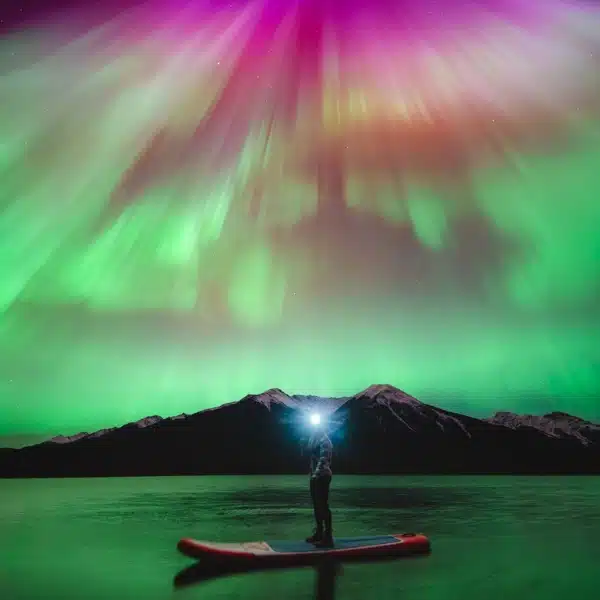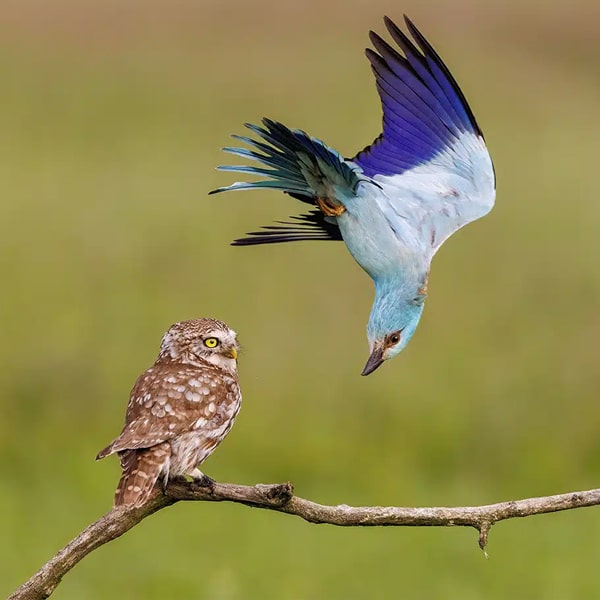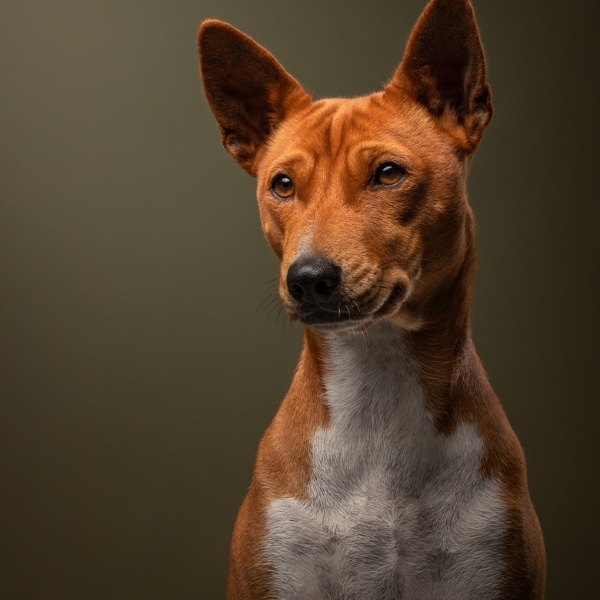
‘The moment' by Yongqing Bao (China). Overall winner. Joint Winner 2019, Behavior: Mammals.
“It was early spring on the alpine meadowland of the Qinghai–Tibet Plateau, in China’s Qilian Mountains National Nature Reserve, and very cold. The marmot was hungry. It was still in its winter coat and not long out of its six-month, winter hibernation, spent deep underground with the rest of its colony of 30 or so. It had spotted the fox an hour earlier, and sounded the alarm to warn its companions to get back underground. But the fox itself hadn’t reacted and was still in the same position. So the marmot had ventured out of its burrow again to search for plants to graze on. The fox continued to lie still. Then suddenly she rushed forward. And with lightning reactions, Yongqing seized his shot. His fast exposure froze the attack. The intensity of life and death was written on their faces – the predator mid-move, her long canines revealed, and the terrified prey, forepaw outstretched, with long claws adapted for digging, not fighting. Such predator-prey interaction is part of the natural ecology of the plateau ecosystem, where rodents, in particular the plateau pikas (smaller than marmots), are keystone species. Not only are they the main prey for foxes and nearly all the other predators, they are key to the health of the grassland, digging burrows that also provide homes for many small animals including birds, lizards and insects, and creating microhabitats that increase the diversity of plant species and therefore the richness of the meadows.”
Canon EOS-1D X + 800mm f5.6 lens; 1/2500 sec at f5.6 (+0.67 e/v); ISO 640; Manfrotto carbon-fibre tripod + 509HD head.
A Tibetan fox rushes forward—teeth exposed—while the marmot it's after screams out in surprise, undoubtedly knowing that its days are numbered. The standoff between these two animals, high in the alpine meadows of the Qinghai-Tibet Plateau, has won photographer Yongqing Bao the title of Wildlife Photographer of the Year. Developed and produced annually by the Natural History Museum, London, the 2019 contest saw over 48,000 entries from 100 countries across 19 categories.
While the standard of photography was high, it was Bao's The Moment that ultimately won over the judges. His scene of horror—and humor—demonstrates just how tough life in the wild can be. Every emotion of the marmot can be felt, as it flings its paws in the air and opens its mouth to cry out. One can almost imagine its scream, as it attempts to warn the rest of the colony about the danger at hand.
“Photographically, it is quite simply the perfect moment,” shares Roz Kidman Cox, head of the judging panel. “The expressive intensity of the postures holds you transfixed, and the thread of energy between the raised paws seems to hold the protagonists in perfect balance. Images from the Qinghai-Tibet Plateau are rare enough, but to have captured such a powerful interaction between a Tibetan fox and a marmot–two species key to the ecology of this high-grassland region–is extraordinary.”
These photographers can spend hours, even months, trying to capture the perfect photo. This could mean slowly gaining the trust of the animal they're looking to photograph or braving sub-zero temperatures for long periods until the scene they desire unfolds. This patience pays big dividends for all involved, including the public that gets the opportunity to enjoy moments they might otherwise miss. From mysterious underwater creatures to animals braving blizzard conditions, the winning photographs help paint a picture of wildlife today.
All of the winning images—along with other highlights—will be on display at the Natural History Museum, London until May 31, 2020, before embarking on a world tour.
See more incredible winning photos from the Wildlife Photographer of the Year contest.

‘Land of the eagle' by Audun Rikardsen, Norway. Winner 2019, Behavior: Birds.
“High on a ledge, on the coast near his home in northern Norway, Audun carefully positioned an old tree branch that he hoped would make a perfect golden eagle lookout. To this, he bolted a tripod head with a camera, flashes and motion sensor attached, and built himself a hide a short distance away. From time to time, he left road kill carrion nearby. Very gradually—over the next three years—a golden eagle got used to the camera and started to use the branch regularly to survey the coast below. Golden eagles need large territories, which most often are in open, mountainous areas inland. But in northern Norway, they can be found by the coast, even in the same area as sea eagles. They hunt and scavenge a variety of prey—from fish, amphibians, and insects to birds and small and medium-sized mammals such as foxes and fawns. They have also been recorded as killing an adult reindeer. But livestock farmers in Norway have accused them of hunting sheep and reindeer rather than just scavenging carcasses, and there is now pressure to make it easier to kill eagles legally. Scientists, though, maintain that the eagles are a scapegoat for livestock deaths and that killing them will have little effect on farmers’ losses. For their size—the weight of a domestic cat but with wings spanning more than 2 meters (61/2 feet)—golden eagles are surprisingly fast and agile, soaring, gliding, diving and performing spectacular, undulating display flights. Audun’s painstaking work captures the eagle’s power as it comes into land, talons outstretched, poised for a commanding view of its coastal realm.”
Canon EOS 5D Mark IV + 11–24mm f4 lens at 11mm; 1/2500 sec at f14 (-1 e/v); ISO 800; Canon Speedlite 600EX II-RT flash; Camtraptions motion sensor; Sirui tripod head.

‘The equal match' by Ingo Arndt (Germany). Joint Winner 2019, Behavior: Mammals.
“Fur flies as the puma launches her attack on the guanaco. For Ingo, the picture marked the culmination of seven months tracking wild pumas on foot, enduring extreme cold and biting winds in the Torres del Paine region of Patagonia, Chile. The female was Ingo’s main subject and was used to his presence. But to record an attack, he had to be facing both prey and puma. This required spotting a potential target—here a big male guanaco grazing apart from his herd on a small hill—and then positioning himself downwind, facing the likely direction the puma would come from. To monitor her movements when she was out of his sight, he positioned his two trackers so they could keep watch with binoculars and radio Ingo as the female approached her prey. A puma is fast—aided by a long, flexible spine (like that of the closely related cheetah)—but only over short distances. For half an hour, she crept up on the guanaco. The light was perfect, bright enough for a fast exposure but softened by thin cloud, and Ingo was in the right position. When the puma was within about 10 meters (30 feet), she sprinted and jumped. As her claws made contact, the guanaco twisted to the side, his last grassy mouthful flying in the wind. The puma then leapt on his back and tried to deliver a crushing bite to his neck. Running, he couldn’t throw her off, and it was only when he dropped his weight on her, seemingly deliberately, that she let go, just missing a kick that could easily have knocked out her teeth or broken bones. Four out of five puma hunts end like this—unsuccessfully.”
Canon EOS-1D X Mark II + 600mm f4 lens; 1/3000 sec at f4; ISO 1000; Gitzo tripod.

“The rat pack” by Charlie Hamilton James (UK). Winner 2019, Urban Wildlife.
“On Pearl Street, in New York’s Lower Manhattan, brown rats scamper between their home under a tree grille and a pile of garbage bags full of food waste. Their ancestors hailed from the Asian steppes, traveling with traders to Europe and later crossing the Atlantic. Today, urban rat populations are rising fast. The rodents are well suited for city living – powerful swimmers, burrowers and jumpers, with great balance, aided by their maligned long tails. They are smart —capable of navigating complex networks such as sewers. They are also social and may even show empathy towards one another. But it’s their propensity to spread disease that inspires fear and disgust. Attempts to control them, though, are largely ineffective. Routine poisoning has led to the rise of resistant rats. Burrows have been injected with dry ice (to avoid poisoning the raptors that prey on them), and dogs have been trained as rat killers. The survivors simply breed (prolifically) to refill the burrows and gorge nightly on any edible trash left around. Lighting his shot to blend with the glow of the street lights and operating his kit remotely, Charlie realized this intimate street-level view.”
Sony α7R III + 16–35mm f4 lens at 24mm; 1/20 sec at f11; ISO 4000; Sony flash; PocketWizard trigger.

‘Night glow' by Cruz Erdmann (New Zealand). Winner 2019, 11-14 years old.
“Cruz was on an organized night dive in the Lembeh Strait off North Sulawesi, Indonesia and, as an eager photographer and speedy swimmer, had been asked to hold back from the main group to allow slower swimmers a chance of photography. This was how he found himself over an unpromising sand flat, in just 3 meters (10 feet) of water. It was here that he encountered the pair of bigfin reef squid. They were engaged in courtship, involving a glowing, fast‑changing communication of lines, spots, and stripes of varying shades and colors. One immediately jetted away, but the other—probably the male—hovered just long enough for Cruz to capture one instant of its glowing underwater show.”
Canon EOS 5D Mark III + 100mm f2.8 lens; 1/125 sec at f29; ISO 200; Ikelite DS161 strobe.

‘Pondworld' by Manuel Plaickner (Italy). Winner 2019 Behavior: Amphibians and Reptiles.
“Every spring, for more than a decade, Manuel had followed the mass migration of common frogs in South Tyrol, Italy. Rising spring temperatures stir the frogs to emerge from the sheltered spots where they spent the winter (often under rocks or wood or even buried at the bottom of ponds). They need to breed and head straight for water, usually to where they themselves were spawned. Mating involves a male grasping his partner, piggyback, until she lays eggs—up to 2,000, each in a clear jelly capsule—which he then fertilizes. Manuel needed to find the perfect pond in the right light at just the right time. Though common frogs are widespread across Europe, numbers are thought to be declining and local populations threatened, mainly by habitat degradation (from pollution and drainage) and disease, and in some countries, from hunting. In South Tyrol there are relatively few ponds where massive numbers of frogs still congregate for spawning, and activity peaks after just a few days. Manuel immersed himself in one of the larger ponds, at the edge of woodland, where several hundred frogs had gathered in clear water. He watched the spawn build up until the moment arrived for the picture he had in mind—soft natural light, lingering frogs, harmonious colors and dreamy reflections. Within a few days, the frogs had gone, and the maturing eggs had risen to the surface.”
Canon EOS 5D Mark II + 17–40mm f4 lens at 20mm; 1/640 sec at f8 (+0.7 e/v); ISO 800; Seacam housing.

‘Tapestry of life' by Zorica Kovacevic (Serbia/U.S.A.). Winner 2019, Plants and Fungi.
“Festooned with bulging orange velvet, trimmed with grey lace, the arms of a Monterey cypress tree weave an otherworldly canopy over Pinnacle Point, in Point Lobos State Natural Reserve, California, USA. This tiny, protected coastal zone is the only place in the world where natural conditions combine to conjure this magical scene. Though the Monterey cypress is widely planted (valued for its resistance to wind, salt, drought, and pests), it is native only on the Californian coast in just two groves. Its spongy orange cladding is, in fact, a mass of green algae spectacularly colored by carotenoid pigments, which depend on the tree for physical support but photosynthesize their own food. The algal species occurs widely, but it is found on Monterey cypress trees only at Point Lobos, which has the conditions it needs—clean air and moisture, delivered by sea breezes and fog. The vibrant orange is set off by the tangles of grey lace lichen (a combination of alga and fungus), also harmless to the trees. After several days experimenting, Zorica decided on a close-up abstract of one particular tree. With reserve visitors to this popular spot confined to marked trails, she was lucky to get overcast weather (avoiding harsh light) at a quiet moment. She had just enough time to focus stack 22 images (merging the sharp parts of all the photos) to reveal the colorful maze in depth.”
Nikon D850 + 70–200mm f2.8 lens at 112mm; 1/4 sec at f8; ISO 64; Really Right Stuff tripod + ballhead.

‘The garden of eels' by David Doubilet (U.S.A.). Winner 2019, Under Water.
“The colony of garden eels was one of the largest David had ever seen, at least two thirds the size of a football field, stretching down a steep sandy slope off Dauin, in the Philippines—a cornerstone of the famous Coral Triangle. He rolled off the boat in the shallows and descended along the colony edge, deciding where to set up his kit. He had long awaited this chance, sketching out an ideal portrait of the colony back in his studio and designing an underwater remote system to realize his ambition. It was also a return to a much-loved subject – his first story of very many stories in National Geographic was also on garden eels. These warm-water relatives of conger eels are extremely shy, vanishing into their sandy burrows the moment they sense anything unfamiliar. David placed his camera housing (mounted on a base plate, with a ball head) just within the colony and hid behind the remnants of a shipwreck. From there he could trigger the system remotely via a 12-meter (40-foot) extension cord. It was several hours before the eels dared to rise again to feed on the plankton that drifted by in the current. He gradually perfected the set-up, each time leaving an object where the camera had been so as not to surprise the eels when it reappeared. Several days later—now familiar with the eels’ rhythms and the path of the light—he began to get images he liked. When a small wrasse led a slender cornetfish through the gently swaying forms, he had his shot.”
Nikon D3 + 17–35mm f2.8 lens at 19mm; 1/40 sec at f14; ISO 400; Seacam housing; aluminium plate + ballhead; remote trigger; Sea & Sea YS250 strobes (at half power).

‘The architectural army' by Daniel Kronauer (U.S.A.). Winner 2019, Behavior: Invertebrates.
“At dusk, Daniel tracked the colony of nomadic army ants as it moved, traveling up to 400 meters (a quarter of a mile) through the rainforest near La Selva Biological Station, northeastern Costa Rica. While it was still dark, the ants would use their bodies to build a new daytime nest (bivouac) to house the queen and larvae. They would form a scaffold of vertical chains (see top right) by interlocking claws on their feet and then create a network of chambers and tunnels into which the larvae and queen would be moved from the last bivouac. At dawn, the colony would send out raiding parties to gather food, mostly other ant species. After 17 days on the move, the colony would then find shelter—a hollow tree trunk, for example—and stay put while the queen laid more eggs, resuming wandering after three weeks. The shape of their temporary bivouacs would depend on the surroundings—most were cone or curtain shaped and partly occluded by vegetation. But one night, the colony assembled in the open, against a fallen branch and two large leaves that were evenly spaced and of similar height, prompting a structure spanning 50 centimeters (20 inches) and resembling ‘a living cathedral with three naves’. Daniel very gently positioned his camera on the forest floor within centimeters of the nest, using a wide-angle to take in its environment, but wary of upsetting a few hundred thousand army ants. ‘You mustn’t breathe in their direction or touch anything connected to the bivouac,’ he says. The result was a perfect illustration of the concept of an insect society as a superorganism.”
Canon EOS 7D + 16–35mm f2.8 lens at 16mm + extension ring; 3.2 sec at f22; ISO 100; Canon Speedlite flash.

‘Another barred migrant' by Alejandro Prieto (Mexico).
Winner 2019, Wildlife Photojournalism: Single Image.
“Under a luminous star-studded Arizona sky, an enormous image of a male jaguar is projected onto a section of the US-Mexico border fence—symbolic, says Alejandro, of ‘the jaguars’ past and future existence in the United States’. Today, the jaguar’s stronghold is in the Amazon, but historically, the range of this large, powerful cat included the southwestern US. Over the past century, human impact—from hunting, which was banned in 1997 when jaguars became a protected species, and habitat destruction—has resulted in the species becoming virtually extinct in the US. Today, two male jaguars are known to inhabit the borderlands of New Mexico and Arizona—probably originating from reserves in northwest Mexico. But with no recent records of a female—a hunter in Arizona shot the last verified female in 1963—any chance of a breeding population becoming re-established rests on the contentious border between the two countries remaining partially open. A penetrable border is also vitally important for many other species at risk, including Sonoran ocelots and migrants such as Sonoran pronghorns. The photograph that Alejandro projected is of a Mexican jaguar, captured with camera traps he has been setting on both sides of the border and monitoring for more than two years. The shot of the border fence was created to highlight President Trump’s plan to seal off the entire US‑Mexico frontier with an impenetrable wall and the impact it will have on the movement of wildlife, sealing the end of jaguars in the US.”
Nikon D850 + Sigma 14–24mm f2.8mm lens at 16mm; 30 sec at f2.8; ISO 1600; remote control; Gitzo tripod; Epson projector.

‘Snow exposure' by Max Waugh (U.S.A.). Winner 2019, Black and White.
“In a winter whiteout in Yellowstone National Park, a lone American bison stands weathering the silent snowstorm. Shooting from his vehicle, Max could only just make out its figure on the hillside. Bison survive in Yellowstone’s harsh winter months by feeding on grasses and sedges beneath the snow. Swinging their huge heads from side to side, using powerful neck muscles – visible as their distinctive humps – they sweep aside the snow to get to the forage below. Slowing his shutter speed to blur the snow and ‘paint a curtain of lines across the bison’s silhouette’, Max created an abstract image that combines the stillness of the animal with the movement of the snowfall. Slightly overexposing it to enhance the whiteout and converting the photograph to black and white accentuated the simplicity of the scene.”
Canon EOS-1D X + 100–400mm f5.6 lens at 200mm; 1/15 sec at f22 (+1 e/v); ISO 100.

‘Snow-plateau nomads' by Shangzhen Fan (China). Winner 2019, Animals in Their Environment
“A small herd of male chiru leaves a trail of footprints on a snow-veiled slope in the Kumukuli Desert of China’s Altun Shan National Nature Reserve. These nimble antelopes – the males with long, slender, black horns – are high-altitude specialists, found only on the Qinghai–Tibet Plateau. To survive at elevations of up to 5,500 meters (18,000 feet), where temperatures fall to -40˚C (-40˚F), they have unique underfur—shahtoosh (Persian for ‘king of wools’)—very light, very warm and the main reason for the species’ drastic decline. A million chiru once ranged across this vast plateau, but commercial hunting in the 1980s and 1990s left only about 70,000 individuals. Rigorous protection has seen a small increase, but demand—mainly from the West—for shahtoosh shawls still exists. It takes three to five hides to make a single shawl (the wool cannot be collected from wild antelopes, so they have to be killed). In winter, many chiru migrate to the relative warmth of the remote Kumukuli Desert. For years, Shangzhen has made the arduous, high altitude journey to record them. On this day the air was fresh and clear after heavy snow. Shadows flowed from the undulating slopes around a warm island of sand that the chiru were heading for, leaving braided footprints in their wake. From his vantage point a kilometer away (more than half a mile), Shangzhen drew the contrasting elements together before they vanished into the warmth of sun and sand.”
Nikon D5 + 600mm f4 lens; 1/1250 sec at f6.3 (+0.3 e/v); ISO 125; Gitzo GT5532S 6X tripod.

‘Creation' by Luis Vilariño Lopez (Spain). Winner 2019, Earth’s Environments.
Red-hot lava tongues flow into the Pacific Ocean, producing huge plumes of noxious laze—a mix of acid steam and fine glass particles—as they meet the crashing waves. This was the front line of the biggest eruption for 200 years of one of the world’s most active volcanos—Kîlauea, on Hawaii’s Big Island. Kîlauea started spewing out lava through 24 fissures on its lower East Rift at the start of May 2018. In a matter of days, traveling at speed, the lava had reached the Pacific on the island’s southeast coast and begun the creation of a huge delta of new land. It would continue flowing for three months. By the time Luis could hire a helicopter with permission to fly over the area, the new land extended more than 1.6 kilometers (a mile) from shore. Luis had limited time to work, with the helicopter forbidden to descend more than 1,000 meters (3,280 feet) and with the noxious clouds of acid vapor filling the sky. He had chosen to fly in late afternoon, so the sidelight would reveal the relief and cloud texture. Thick clouds of laze covered the coast, but as dusk fell, there was a sudden change in wind direction and the acidic clouds moved aside to reveal a glimpse of the lava lagoons and rivers. Framing his shot through the helicopter’s open door, Luis captured the collision boundary between molten rock and water and the emergence of new land.”
Sony α7R III + 100–400mm f4.5–5.6 lens at 196mm; 1/4000 sec at f5.6; ISO 800.
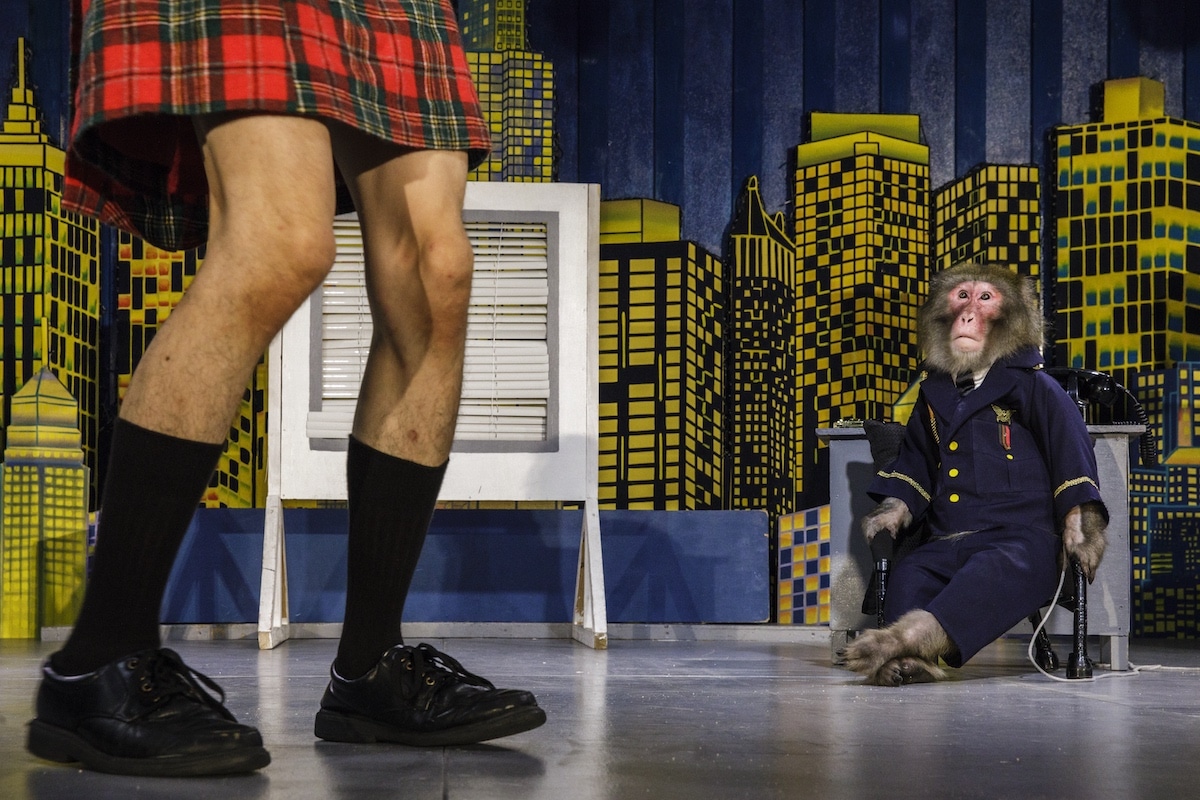
‘Show time' by Jasper Doest (Netherlands). Winner 2019, Wildlife Photojournalist Story Award.
“For the past 17 years Riku, a Japanese macaque legally captured from the wild, has performed comedy skits three times a day in front of large audiences at the Nikkō Saru Gundan theater north of Tokyo. These highly popular shows, which attract both locals and tourists, derive from Sarumawashi (translated as ‘monkey dancing’)—a traditional Japanese performance art that has been around for more than 1,000 years. The appeal of these contemporary performances lies in the anthropomorphic appearance of the trained macaques—invariably dressed in costumes—that move around the stage on two legs performing tricks and engaging in ridiculous role-plays with their human trainers. Photography is banned at shows, and so it took a long time for Jasper to gain permission to take pictures. Recording Riku’s performance on stage—here with one of the trainers dressed in a Scottish kilt—he was appalled that such intelligent animals, once considered sacred, are now exploited for laughs. Riku was finally retired in 2018.”
Canon EOS 5D Mark IV + 24–70mm f2.8 lens; 1/160 sec at f10 (-1.7 e/v); ISO 2000.

‘Humming surprise' by Thomas Easterbrook (United Kingdom). Winner 2019, 10 years and under.
“On holiday with his family in France, Thomas was eating supper in the garden on a warm summer’s evening when he heard the humming. The sound was coming from the fast-beating wings of a hummingbird hawkmoth, hovering in front of an autumn sage, siphoning up nectar with its long proboscis. Its wings are reputed to beat faster than the hummingbirds that pollinate the plant in its native home of Mexico and Texas. With the moth moving quickly from flower to flower it was a challenge to frame a picture. But Thomas managed it, while capturing the stillness of the moth’s head against the blur of its wings.”
Sony DSC-HX400V + 24–210mm f2.8–6.3 lens at 51mm; 1/320 sec at f5; ISO 80.

‘Early riser' by Riccardo Marchgiani (Italy). Winner 2019, 15-17 years old.
“Riccardo could not believe his luck when, at first light, this female gelada, with a week-old infant clinging to her belly, climbed over the cliff edge close to where he was perched. He was with his father and a friend on the high plateau in Ethiopia’s Simien Mountains National Park, there to watch geladas—a grass-eating primate found only on the Ethiopian Plateau. At night, the geladas would take refuge on the steep cliff faces, huddling together on sleeping ledges, emerging at dawn to graze on the alpine grassland. On this day, a couple of hours before sunrise, Riccardo’s guide again led them to a cliff edge where the geladas were likely to emerge, giving him time to get into position before the geladas woke up. He was in luck. After an hour’s wait, just before dawn, a group started to emerge not too far along the cliff. Moving position while keeping a respectful distance—and away from the edge—Riccardo was rewarded by this female, who climbed up almost in front of him. Shooting with a low flash to highlight her rich brown fur against the still-dark mountain range, he caught not only her sideways glance but also the eyes of her inquisitive infant.”
Nikon D800E + 16–35mm f4 lens at 30mm; 1/60 sec at f8; ISO 100; Godox V860II-N flash.

‘The huddle' by Stefan Christmann (Germany).
Winner 2019, Wildlife Photographer of the Year Portfolio Award.
“More than 5,000 male emperor penguins huddle against the wind and late winter cold on the sea ice of Antarctica’s Atka Bay, in front of the Ekström Ice Shelf. It was a calm day, but when Stefan took off his glove to delicately focus the tilt-shift lens, the cold ‘felt like needles in my fingertips’. Each paired male bears a precious cargo on his feet—a single egg—tucked under a fold of skin (the brood pouch) as he faces the harshest winter on Earth, with temperatures that fall below -40˚C (-40˚F), severe wind chill and intense blizzards. The females entrust their eggs to their mates to incubate and then head for the sea, where they feed for up to three months. Physical adaptations—including body fat and several layers of scale-like feathers, ruffled only in the strongest of winds—help the males endure the cold, but survival depends on cooperation. The birds snuggle together, backs to the wind and heads down, sharing their body heat. Those on the windward edge peel off and shuffle down the flanks of the huddle to reach the more sheltered side, creating a constant procession through the warm center, with the whole huddle gradually shifting downwind. The center can become so cozy that the huddle temporarily breaks up to cool off, releasing clouds of steam. From mid‑May until mid-July, the sun does not rise above the horizon, but at the end of winter, when this picture was taken, there are a few hours of twilight. That light combined with modern camera technology and a longish exposure enabled Stefan to create such a bright picture.”
Nikon D810 + 45mm f2.8 tilt-shift lens; 1/60 sec at f11; ISO 800; Gitzo 5562LTS tripod + Novoflex CB5II ballhead.
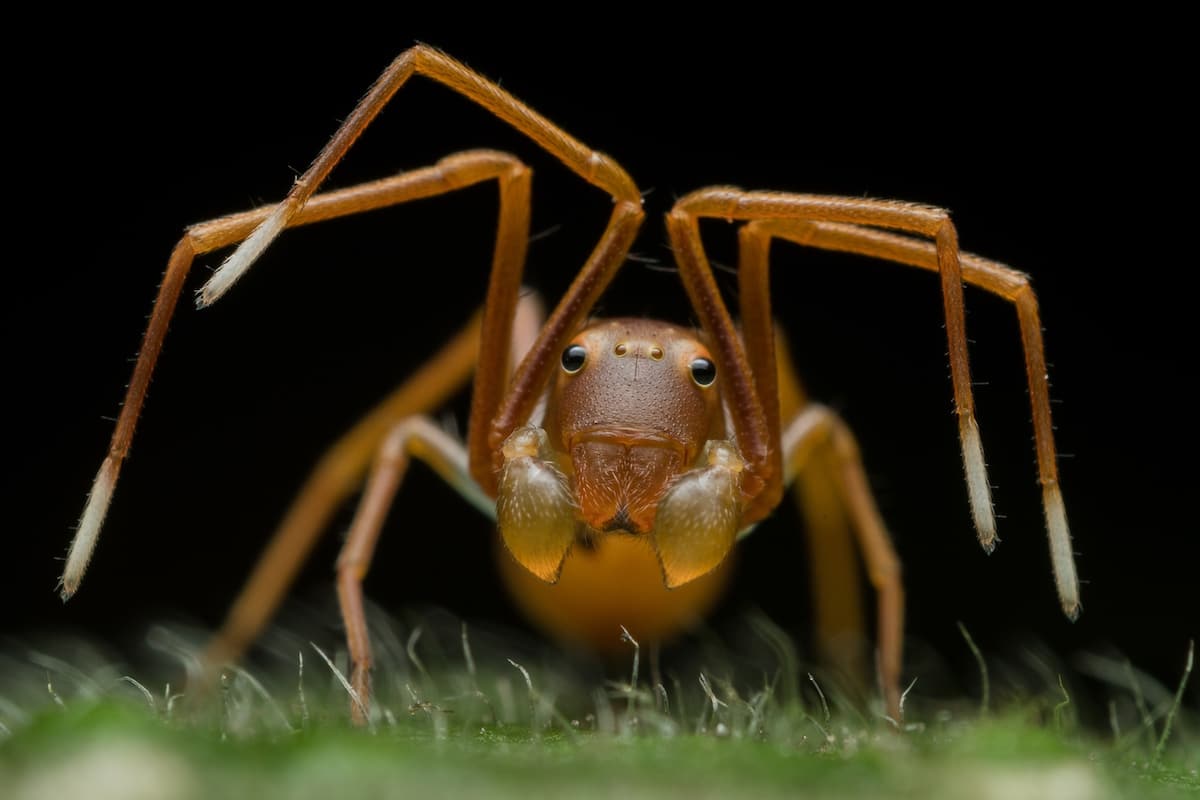
‘Face of deception' by Ripan Biswas (India). Winner 2019, Animal Portraits.
“It may look like an ant, but then count its legs—and note those palps either side of the folded fangs. Ripan was photographing a red weaver ant colony in the subtropical forest of India’s Buxa Tiger Reserve, in West Bengal, when he spotted the odd-looking ant. On a close look, he realized it was a tiny ant-mimicking crab spider, just 5 millimeters (1/5 inch) long. Many spider species imitate ants in appearance and behavior—even smell. Infiltrating an ant colony can help a spider wanting to eat ants or to avoid being eaten by them or by predators that dislike ants. This particular spider seemed to be hunting. By reverse mounting his lens, Ripan converted it to a macro, capable of taking extreme close-ups. But with the electrical connection lost between the lens and camera, settings had to be adjusted manually, and focusing was tricky, as the viewfinder became dark while he narrowed the aperture to maximize the depth of field. Here, the lens was so close that the diminutive arachnid seems to have been able to see its reflection and is raising its legs as a warning.”
Nikon D500 + 18–55mm lens (reverse mounted); 1/160 sec; ISO 200; Godox V860II flash.

‘Frozen moment' by Jérémie Villet (France). Winner 2019, Rising Star Portfolio Award.
“Pushing against each other, two male Dall’s sheep in full winter-white coats stand immobile at the end of a fierce clash on a windswept snowy slope. For years, Jérémie had dreamed of photographing the pure-white North American mountain sheep against snow. Traveling to the Yukon, he rented a van and spent a month following Dall’s sheep during the rutting season, when mature males compete for mating rights. On a steep ridge, these two rams attempted to duel, but strong winds, a heavy blizzard and extreme cold (-40°) forced them into a truce. Lying in the snow, Jérémie was also battling with the brutal weather—not only were his fingers frozen, but the ferocious wind was making it difficult to hold his lens steady. So determined was he to create the photograph he had in mind that he continued firing off frames, unaware that his feet were succumbing to frostbite, which it would take months to recover from. He had just one sharp image, but that was also the vision of his dreams—the horns and key facial features of the mountain sheep etched into the white canvas, their fur blending into the snowscape.”
Canon EOS 5D Mark IV + 400mm f2.8 lens; 1/1600 sec at f2.8 (+1.3 e/v); ISO 500.













































































